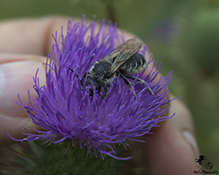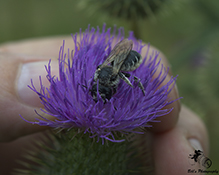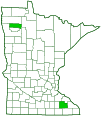alfalfa leafcutting bee
(Megachile rotundata)
Conservation • Description • Habitat • Ecology • Distribution • Taxonomy
|
|
||||||||||||||
Description |
Alfalfa leafcutting bee is a small, exotic, solitary, leafcutting bee. It is native to southwestern Asia and southeastern Europe. It was imported into the United States for agriculture by the 1940s, and is now naturalized. At less than a centimeter (⅜″) in length, alfalfa leafcutting bee is the smallest leafcutting bee. Females are 5 ⁄16″ to ⅜″ long. Males are a little smaller, ¼″ to 5 ⁄16″ in length. The thorax is black. The small plate covering the base of each forewing (tegula) is dark brown to reddish-brown. The hardened plate on the upper (dorsal) side of the first segment of the thorax (pronotum) is saddle-shaped. It has a small rounded lobe on each side that does not reach the tegula. The sides and rear (posterior) of the thorax are densely covered with long white hairs. The upper (dorsal) side is sparsely covered with short white hairs on the female, longer yellowish hairs on the male. The first abdominal segment is fused to the thorax and gives the thorax the appearance of having four segments. The abdomen is black. The second through fifth segments (T2 through T5) have a narrow, very dense patch of short, whitish, rear-facing hairs, giving the abdomen a narrowly striped appearance. The underside of the abdomen is densely covered with long, branched, electrostatically charged hairs (scopa) used for collecting pollen. On the female, the scopa are entirely white on segments 2 through 4, white at the base with black tips on segment 5, and entirely black on segment 6. Males have white and yellow spots on the abdomen. The head is black. The face is covered with yellowish hairs, sparsely at the top of the head, densely around the antennae and at the sides of the face. There are two large compound eyes, one on each side of the head; and three small simple eyes (ocelli) in a triangular pattern at the top of the head between the compound eyes. The antennae are thread-like and are not elbowed. They have 12 segments. The mandibles have 4 teeth. The tongue is long and slender. The legs are black. Unlike most bees, there are no pollen-collecting hairs (scopa) on the hind legs. |
Size |
Female: 5 ⁄16″ to ⅜″ Male: ¼″ to 5 ⁄16″ |
Similar Species |
Habitat |
A wide variety of habitats |
Ecology |
Season |
One generation: June through August |
Behavior |
|
Life Cycle |
Breeding occurs in June and July. The female builds a tubular nest in the ground or in a crevice in rotten wood. She cuts circular disks of leaves, about 1″ in diameter, placing about 15 of them at the bottom of the first cell. She then provisions the cell with pollen and regurgitated nectar, and lays a single egg. She then seals the cell with more leaf disks. She continues this process until she has laid 18 to 25 or more eggs. The larvae undergo four instar stages. Some will emerge as adults later in the summer. Others will enter a pre-pupal, hibernation-like phase (diapause), overwinter, pupate in the spring, and emerge as adults the following summer. |
Larva Food |
Flower nectar and pollen |
Adult Food |
Nectar and pollen of a variety of plants, but especially alfalfa. Unlike most bees, the alfalfa leafcutting bee is able to pry open the alfalfa flower, insert its long proboscis, and extract nectar. While doing this, pollen attaches to the electrostatically charged hairs on the base of the bee’s abdomen. This makes it especially well suited to pollinate alfalfa crops. The species has been exported to all parts of the world and is now found on all continents except Antarctica. |
Distribution |
||
|
Sources Biodiversity occurrence data published by: Minnesota Biodiversity Atlas (accessed through the Minnesota Biodiversity Atlas Portal, bellatlas.umn.edu, 9/3/2024). |
|
| 9/3/2024 | ||
Occurrence |
||
Common and widespread |
||
Taxonomy |
|
Order |
Hymenoptera (Ants, Bees, Wasps, and Sawflies) |
Suborder |
Apocrita (Narrow-waisted Wasps, Ants, and Bees) |
Infraorder |
Aculeata (ants, bees, and stinging wasps) |
Superfamily |
Apoidea (bees and apoid wasps) |
Epifamily |
|
Family |
Megachilidae (mason, leafcutter, carder, and resin bees) |
Subfamily |
Megachilinae |
Tribe |
Megachilini |
Genus |
|
Subgenus |
Eutricharaea |
Subordinate Taxa |
|
|
|
Synonyms |
|
Apis pacifica Apis rotundata Megachile imbecilla Megachile nadia Megachile pruinosa |
|
Common Names |
|
alfalfa leafcutter bee alfalfa leafcutting bee lucerne leafcutter bee (Australia) |
|
Glossary
Diapause
A period of decreased metabolic activity and suspended development.
Pronotum
The exoskeletal plate on the upper side of the first segment of the thorax of an insect.
Scopa
A brush-like tuft of hairs on the legs or underside of the abdomen of a bee used to collect pollen.
Tegula
A small, hardened, plate, scale, or flap-like structure that overlaps the base of the forewing of insects in the orders Lepidoptera, Hymenoptera, Diptera, and Homoptera. Plural: tegulae.
Visitor Photos |
||
Share your photo of this insect. |
||
This button not working for you? |
||
Alfredo Colon |
||
 |
 |
|
 |
 |
|
 |
 |
|
Bill Reynolds |
||
 |
||
MinnesotaSeasons.com Photos |
||
|
||
|
||

Slideshows |
|

Visitor Videos |
||
Share your video of this insect. |
||
This button not working for you? |
||
|
Other Videos |
||
Alfalfa Leafcutter Bee (Megachilidae: Megachile rotundata) Close-up of Female on Ledge |
About
Published on Jul 25, 2011 Photographed at Grand Forks, North Dakota (25 July 2011). Thank you to John Ascher (@Bugguide.net) for identifying this specimen! |

Created: 8/25/2017 Last Updated: © MinnesotaSeasons.com. All rights reserved. |




